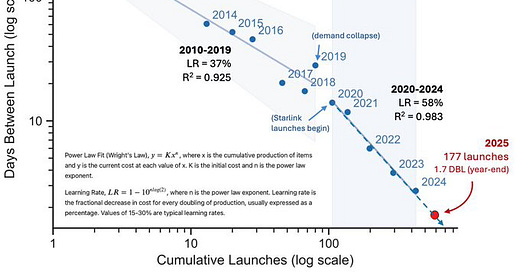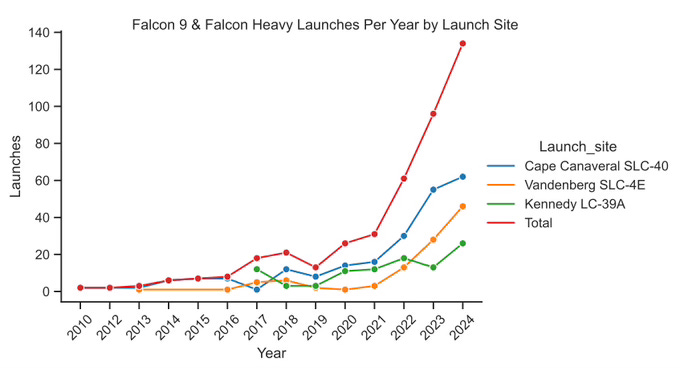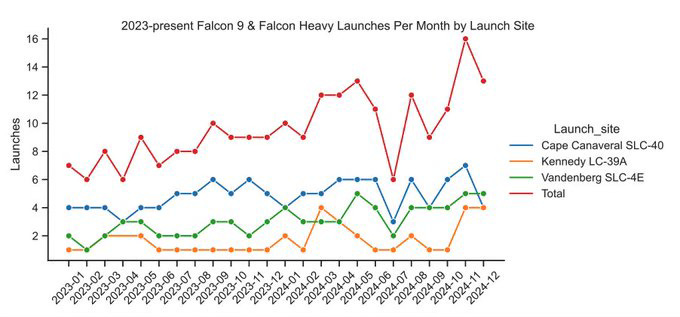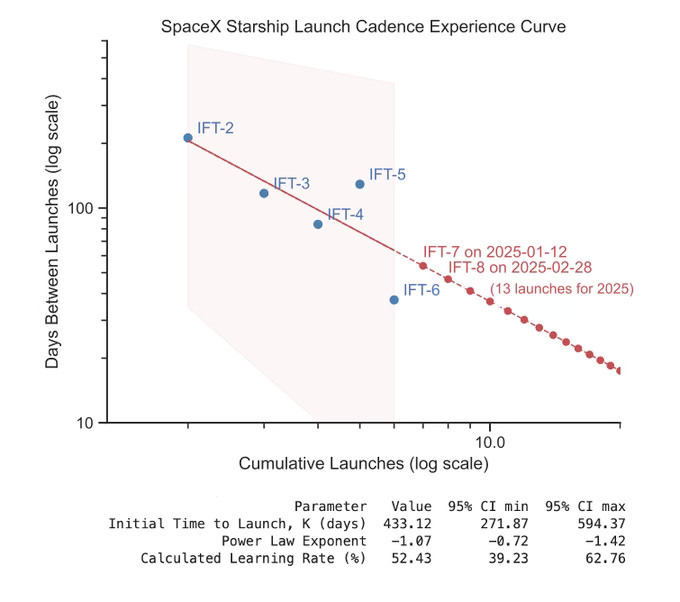Falcon 9 and Starship launch cadence learning curves for 2024
SpaceX Falcon 9 continues to increase launch cadence 58% for every doubling of total number of launches. Starship at 52%.
During 2024, the time between launches for SpaceX’s reusable Falcon 9 rocket continued to decrease by 58% for each doubling of the number of total launches (Wright’s Law learning rate). The launch cadence learning rate reflects the aggregated pace of improvement across many facets of SpaceX operations: manufacturing of the (non-reusable) second stage and Starlink satellites, refurbishment of the first stage and second stage fairings, launch pad preparations, recovery vessel scheduling, etc.
As I’ve written before, the data show a noticeable shift from the 2010-2019 learning rate of 37%, to the consistent 58% learning rate from 2020 to today, probably due to the relatively uncapped demand that came along with the introduction of Starlink satellite payloads. In the early days, increasing the number of customer payloads might have been as much of a bottleneck as operational innovation.
In any event, based on the current 58% learning rate, 177 launches are predicted for 2025, reaching a cadence of one launch every 1.7 days by year-end. Elon Musk has stated their goal will in fact be 180 launches.
For context, I’ve included the charts below that show the annual and monthly numbers of launches broken out for each of the three SpaceX launch pads. In the annual data, SLC-40 and Vandenberg clearly show the greatest increases in cadence over the years, while LC-39A has a lower rate of improvement, possibly a reflection of the more complex activities at that location.
The impact of (and recovery from) this past year’s anomalies are clearly seen in the July 2024 temporary drop in launches:
Finally, I’ve included the current launch cadence learning curve for Starship which, at a 52% learning rate, predicts 13 launches for 2025, starting on 12 Jan (2/7/2025 update: IFT-7 launched on Jan 16, 2025).
Wright’s Law has been used successfully to project costs for a wide variety of industries for over a century, with observed learning rates typically in the range of 10-30%. For over a decade SpaceX has shown a remarkably high and remarkably sustained learning rate for reduction in the “cost” of time between launches. In the coming years, it will be interesting to see if SpaceX can maintain this pace of improvement, especially for Starship, and how other launch organizations will compare.
—
Notes:
(1) I left in the large 95% confidence interval (blue shading) for the 2020-2024 Falcon 9 curve fit graphic. The wide range is due to the large uncertainty in the intercept, K, the initial “time cost” to launch. This is a consequence of the 2019-2020 breakpoint which renders calculated K meaningless for later portions of the learning curve. In contrast, the uncertainty in the 2020-2024 slope, n, is quite reasonable; the calculated learning rate is 58% with a 95% confidence interval of 48-66%. For the 2010-2019 fit, the initial time to launch, K is a reasonable 371 days, 95% CI = 266 - 517 days.
(2) Data from wikipedia, linear fitting done with log transformed data. Direct power law fitting gives some unrealistic results, possibly because the fitting algorithm overweights data points with large days between launch (but therefore very small sample size) and underweights small days between launches (despite large sample size).
(3) This is a slightly updated re-post of a reddit post and X article from January 2024.







